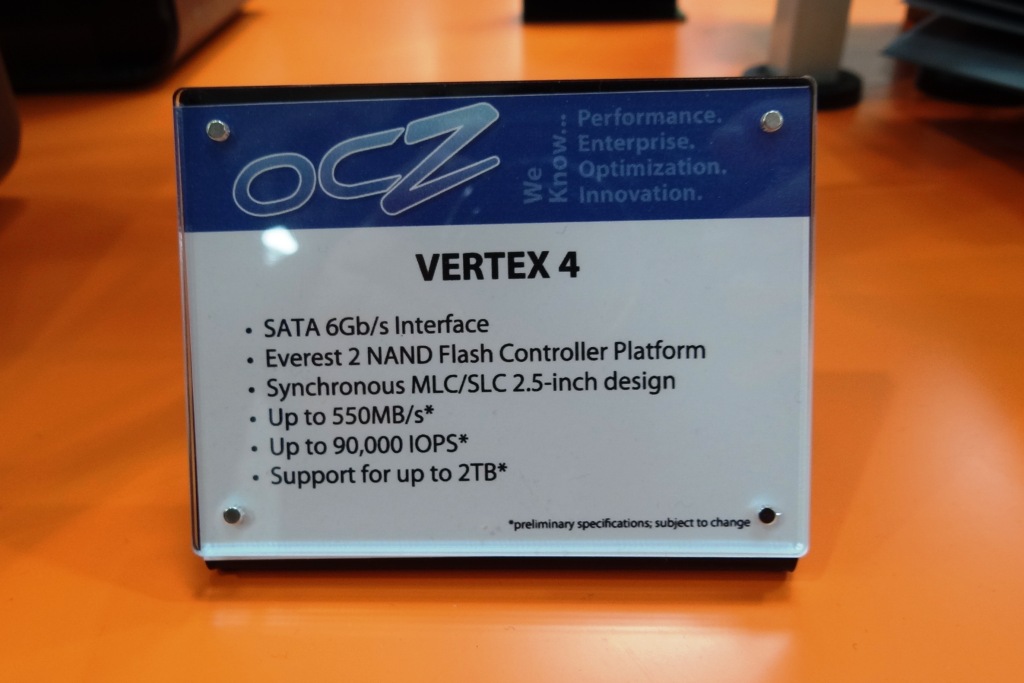Our first visit to the OCZ Booth at CeBIT 2012 was a bit ‘rushed’ as we saw a flurry of first day guests invading the hangars as many companies were still fine tuning their displays.
Such was the case with our visit to the OCZ booth which remains to be one of the busiest displays of the show. We have been trying to find a time to do a bit of Vertex 4 testing which is not the easiest thing to do with so many bumping and pushing as they pass. The OCZ suites we have seen at CES and Computex definitely had their advantages.
Nevertheless we accomplished what we set out to do and got some additional piks and benchmarks on the Vertex 4. No date has been announced for its release but a betting person would believe that we will see it released prior to, if not for, Computex in June.
 The drive we tested was in it’s third day of testing and, in no way, a fresh drive that one might typically see top results from. In speaking with an OCZ engineer, however, we learned that the drive shown still uses preliminary firmware and OCZ believes that these specs will be valid on release.
The drive we tested was in it’s third day of testing and, in no way, a fresh drive that one might typically see top results from. In speaking with an OCZ engineer, however, we learned that the drive shown still uses preliminary firmware and OCZ believes that these specs will be valid on release.
 Anyone who knows anything about SSDs loves this shot, as I do, simply because that low 4k random write score of 106MB/s is so hard to match and so important to visible performance during typical user operation. Once again, this is a good time to mention that this is the third day of use for this SSD in a ‘tech conference’ environment.
Anyone who knows anything about SSDs loves this shot, as I do, simply because that low 4k random write score of 106MB/s is so hard to match and so important to visible performance during typical user operation. Once again, this is a good time to mention that this is the third day of use for this SSD in a ‘tech conference’ environment.
 85524 IOPS shown here is very close to the spec of 90,000 IOPS that should be seen on release. Enthusiast interest in the V4 is at a peak for just this reason.
85524 IOPS shown here is very close to the spec of 90,000 IOPS that should be seen on release. Enthusiast interest in the V4 is at a peak for just this reason. Tried as only we could, we were still unable to get them to pop open a drive for some shots of the PCB and components. Hopefully, we will see these drives on our bench for testing soon enough.
Tried as only we could, we were still unable to get them to pop open a drive for some shots of the PCB and components. Hopefully, we will see these drives on our bench for testing soon enough.
 The SSD Review The Worlds Dedicated SSD Education and Review Resource |
The SSD Review The Worlds Dedicated SSD Education and Review Resource | 
Was there anything from OCZ in the 2.5″ enterprise market?
what is the difference between 4k write/read and IOPS?
how do you convert them?
Take the 4K QD32-value.
Divide by 4 and multiply by 1000 to get IOPS.
From what I can gather, the V4 will launch using 25nm sync nand and a faster, (MaxIOP maybe), with 24nm toggle won’t be far behind.
cant wait to see your writeup les 🙂
Max IOPS Vertex 3 held onto the 32nm Flash Memory (longer lifespan) compared to the 2xnm the normal Vertex 3 featured. Hoping they’ll keep it up, as I prefer the 32 to the 2x right now.